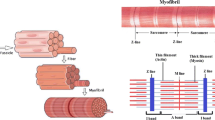Abstract
A system involving two kinds of sliding filaments is analysed with special attention to the actomyosin system. Rigorous results are obtained about the statistical effect originating from many active sites distributed on both filaments. It is necessary for the occurrence of smooth motion in sliding filament that the spatial periods of active sites on both filaments are relatively incommensurable, and that the number of active sites on each filament is large enough. Sufficient conditions for smooth contraction are derived under the assumption that both filaments are rigid; this is called rigid rod approximation in the present paper. The elastic mode of the filaments, during the sliding process, is analysed by perturbation theory based on the rigid rod approximation. A stochastic theory is briefly discussed in reference to the cooperative generation of contractile force, which is concerned in Hill's relation of muscle contraction.
Similar content being viewed by others
Literature
Aiello, E. and M. A. Sleigh. 1972. “The Metachronical Wave of Lateral Cilia ofMytilus edulis.”J. Cell. Biol. 54, 493–506.
Aizawa, Y. 1979. “a Mathematical Model of Ciliary Movement.” In preparation.
Elliott, G. F., J. Lowy and B. M. Millman. 1967. “Low-angle X-ray Diffraction Studies of Living Striated Muscle during Contraction.”J. Molec. Biol.,25, 31–45.
Ford, L. E., A. F. Huxley and R. M. Simmons. 1977. “Tension Responses to Sudden Length Change in Stimulated Frog Muscle Fibres Near Slack Length.”J. Physiol. 269, 441–515.
Glandsorff, P. and I. Prigogine. 1971.Thermodynamic Theory of Structure, Stability and Fluctuation. New York: Wiley.
Gray, J. 1931. “The Mechanism of Ciliary Movement. Photographic Stroboscopic Analysis of Ciliary Movement.”Proc. R. Soc. Lond.,B107, 313–332.
Huxley, A. F. 1957. “Muscle Structure and Theories of Contraction.”Prog. Biophys. Chem.,7, 255–318.
— 1971. “The Activation of Striated Muscle and its Mechanical Response.”Proc. R. Soc.,B178, 1–27.
— and R. M. Simmons. 1971. “Proposed Mechanism of Force Generation in Striated Muscle.”Nature 233, 533–538.
Huxley, H. E. and J. Hanson. 1954. “Changes in the Cross-striations of Muscle during Contraction and Stretch and their Structural Interpretation.”Nature,173, 973–976.
— and W. Brown. 1967. “The Low-angle X-ray Diagram of Vertebrate Striated Muscle and its Behavior During Conraction and Rigor.”J. Molec. Biol.,30, 383–434.
Nicolis, G. and I. Prigogine. 1977. “Self-organization in Nonequilibrium System.” New York: Wiley.
Nishiyama, K. 1977. Private communication.
Shimizu, H., T. Yamada, K. Nishiyama and M. Yano. 1976. “Energetic Enzyme Theory of Muscular Contraction. II. Relation Between Hill's Equation and Functions of Two-head Myosin.”J. Theor. Biol.,63, 165–189.
Tomita, K. 1973. “A Model of Muscle Contraction.” InSynergetics (Ed. by H. Haken and B. G. Teubner), pp. 232–240.
Author information
Authors and Affiliations
Rights and permissions
About this article
Cite this article
Aizawa, Y., Shimizu, H. An exact analysis of the sliding motion in contractile system: A simplified model of muscle system. Bltn Mathcal Biology 41, 813–828 (1979). https://doi.org/10.1007/BF02462378
Received:
Revised:
Issue Date:
DOI: https://doi.org/10.1007/BF02462378




